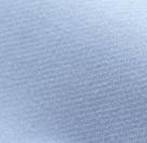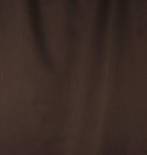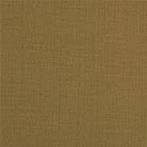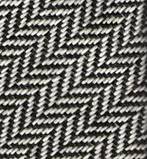 Chances are if you’re like most guys, you purchase dress shirts based on color, pattern, and style, which probably works out most of the time. However, if you would like to up the ante, factor fabric into your choice, as well, for the ultimate shirt buying experience. I realize doing so can add more confusion to an already challenging venture, but understanding the various fabrics, and what they offer, can make the difference between an okay shirt and a great one.
Chances are if you’re like most guys, you purchase dress shirts based on color, pattern, and style, which probably works out most of the time. However, if you would like to up the ante, factor fabric into your choice, as well, for the ultimate shirt buying experience. I realize doing so can add more confusion to an already challenging venture, but understanding the various fabrics, and what they offer, can make the difference between an okay shirt and a great one.
Most dress shirts are categorized into two groups: cotton and cotton blends. Most fabrics are named for the way they are woven, versus the material used to make the shirt. This can make things a bit more perplexing, since the names don’t always tip us off to the exact kind of fabric, like cotton for instance; however, the label inside the shirt should disclose the type of fabric used.
Most Widely Used Dress Shirt Fabrics
Whether the shirt is made of cotton or a cotton blend, every fabric listed below, except linen, can be found in either version. Here’s a list of the most widely used dress shirt fabrics, their comfort level, and when to wear them. Let me add that when referring to shirt fabric, the word “shirtings” is the professional terminology, at least among tailors and other clothiers.
 Oxford: This fabric or shirting is where the Oxford dress shirt gets its name. Typically, this cloth is coarser than other dress shirt fabrics, resulting in a more casual fabric and shirt; however, it’s still soft and comfortable to wear. Oxfords are usually recognized by their button-down collar, which is a more casual collar style that compliments this type fabric, yet some oxfords do have spread collars instead. There are different degrees of coarseness, and finer oxford fabric is used to make the Pinpoint and Royal Oxfords, whose fine yarn makes them a more formal dress shirt than the average oxford. Regardless of the fabric, all oxfords are woven the same way. Threads running in one direction are white, while the others are colored, unless the shirt is white, and then all threads are white. This style weave gives the oxford shirting its textured look. Because this fabric is a heavier material, the oxford shirt wears best in cooler months.
Oxford: This fabric or shirting is where the Oxford dress shirt gets its name. Typically, this cloth is coarser than other dress shirt fabrics, resulting in a more casual fabric and shirt; however, it’s still soft and comfortable to wear. Oxfords are usually recognized by their button-down collar, which is a more casual collar style that compliments this type fabric, yet some oxfords do have spread collars instead. There are different degrees of coarseness, and finer oxford fabric is used to make the Pinpoint and Royal Oxfords, whose fine yarn makes them a more formal dress shirt than the average oxford. Regardless of the fabric, all oxfords are woven the same way. Threads running in one direction are white, while the others are colored, unless the shirt is white, and then all threads are white. This style weave gives the oxford shirting its textured look. Because this fabric is a heavier material, the oxford shirt wears best in cooler months.
 Poplin: This, too, is a casual fabric that is used for making casual shirts. About the same weight as the oxford, poplin is smoother, due to the combination of fine and thick yarns that intertwine each other. It has a crispness to it, which looks great, and it retains colors and patterns very well, also. This is another good choice for cool weather; however, depending on what poplin’s made of, it can be fairly pricey.
Poplin: This, too, is a casual fabric that is used for making casual shirts. About the same weight as the oxford, poplin is smoother, due to the combination of fine and thick yarns that intertwine each other. It has a crispness to it, which looks great, and it retains colors and patterns very well, also. This is another good choice for cool weather; however, depending on what poplin’s made of, it can be fairly pricey.
 Linen: One of the oldest woven fabrics in human history, linen was once used only by royalty. Made from the stems of the flax plant, linen was and still is expensive to manufacture. Today’s linen shirts are considered more casual and suitable for us commoners, and they look great with jeans and other casual pants and shorts. Its characteristic “slubs” or small knots reflect the fabric’s quality. Finer linen has less slubs, where lesser quality linen has more – both reflected by the price tag. It’s very lightweight and breathable, which makes it ideal for summer and warm weather. Although it’s known to wick perspiration away, sweat easily stains the fabric. Another downside to linen is it wrinkles like a Shar-Pei puppy, so expect to spend more time ironing this fabric.
Linen: One of the oldest woven fabrics in human history, linen was once used only by royalty. Made from the stems of the flax plant, linen was and still is expensive to manufacture. Today’s linen shirts are considered more casual and suitable for us commoners, and they look great with jeans and other casual pants and shorts. Its characteristic “slubs” or small knots reflect the fabric’s quality. Finer linen has less slubs, where lesser quality linen has more – both reflected by the price tag. It’s very lightweight and breathable, which makes it ideal for summer and warm weather. Although it’s known to wick perspiration away, sweat easily stains the fabric. Another downside to linen is it wrinkles like a Shar-Pei puppy, so expect to spend more time ironing this fabric.
 Broadcloth: Given its name because it was woven in widths exceeding 29 inches, broadcloth was traditionally made of silk or wool, while today’s broadcloth manufactured for shirts is usually cotton or a cotton blend. Regardless, it’s a tightly woven, plain fabric that has a slight ribbing. It’s very similar to poplin, and it’s soft, lustrous, smooth finish make it a very dressy fabric. Broadcloth is typically a thinner, lighter material, making it ideal for shirts worn under suit jackets and blazers. Its lighter weight also makes it ideal for warm weather; however, it’s worn year round. Let me add that white broadcloth is somewhat transparent, so factor that in when wearing it. High quality broadcloth does not wrinkle easily; however, cheaper grades do. Overall, it wears very well, and is used to manufacture the most formal of dress shirts.
Broadcloth: Given its name because it was woven in widths exceeding 29 inches, broadcloth was traditionally made of silk or wool, while today’s broadcloth manufactured for shirts is usually cotton or a cotton blend. Regardless, it’s a tightly woven, plain fabric that has a slight ribbing. It’s very similar to poplin, and it’s soft, lustrous, smooth finish make it a very dressy fabric. Broadcloth is typically a thinner, lighter material, making it ideal for shirts worn under suit jackets and blazers. Its lighter weight also makes it ideal for warm weather; however, it’s worn year round. Let me add that white broadcloth is somewhat transparent, so factor that in when wearing it. High quality broadcloth does not wrinkle easily; however, cheaper grades do. Overall, it wears very well, and is used to manufacture the most formal of dress shirts.
 Twill: When looking for a solid color dress shirt, consider twill. Its shinny, tight diagonal weave gives this fabric a nicely textured finish that does not take away from its formalness. The weave allows it to drape well, and makes it a softer fabric than broadcloth. It doesn’t give that crisp look like pressed broadcloth does, but it’s easy to iron and resists wrinkles… which is a definite plus. All twill has a noticeable front and backside, unlike plain fabric, and has a high thread count. Patterned twill is usually made of lighter yarn, so expect a lighter weight shirt. It normally wears very well, and although the weave is used for many types of clothing, like jeans and chinos, dress shirt fabric is very stylish, and considered the perfect dress shirt by many. Normally of medium weight, twill dress shirts can be comfortably worn year round. Herringbone twill falls under the twill category.
Twill: When looking for a solid color dress shirt, consider twill. Its shinny, tight diagonal weave gives this fabric a nicely textured finish that does not take away from its formalness. The weave allows it to drape well, and makes it a softer fabric than broadcloth. It doesn’t give that crisp look like pressed broadcloth does, but it’s easy to iron and resists wrinkles… which is a definite plus. All twill has a noticeable front and backside, unlike plain fabric, and has a high thread count. Patterned twill is usually made of lighter yarn, so expect a lighter weight shirt. It normally wears very well, and although the weave is used for many types of clothing, like jeans and chinos, dress shirt fabric is very stylish, and considered the perfect dress shirt by many. Normally of medium weight, twill dress shirts can be comfortably worn year round. Herringbone twill falls under the twill category.
 Brush Twill: This is a variation of twill, but is much softer and less shiny. It has a fuzzy feel to it and is very comfortable. This is definitely a casual fabric that’s fairly warm, so wear in cooler weather. Flannel shirts are typically brushed twill.
Brush Twill: This is a variation of twill, but is much softer and less shiny. It has a fuzzy feel to it and is very comfortable. This is definitely a casual fabric that’s fairly warm, so wear in cooler weather. Flannel shirts are typically brushed twill.
 Herringbone: This is also a twill fabric that offers even more texture and depth than other twill fabrics, due to the diagonal back and forth pattern reversing direction every so often and less frequently than other twills. The herringbone V-pattern comes in a variety of sizes, ranging from barely perceptible to large and loud. It got its name because it looks like the skeleton of a herring fish. Most herringbone fabric is wool, making it the most popular material for suits, jackets, and overcoats. Shirts can be made from wool, but they’re usually cotton or cotton blends. If so, wear it the same as you would twill.
Herringbone: This is also a twill fabric that offers even more texture and depth than other twill fabrics, due to the diagonal back and forth pattern reversing direction every so often and less frequently than other twills. The herringbone V-pattern comes in a variety of sizes, ranging from barely perceptible to large and loud. It got its name because it looks like the skeleton of a herring fish. Most herringbone fabric is wool, making it the most popular material for suits, jackets, and overcoats. Shirts can be made from wool, but they’re usually cotton or cotton blends. If so, wear it the same as you would twill.
Fabric Thread Count and Ply
Dress shirts are given a thread count. When comparing shirts, if all factors are the same: type of yarn, weave, ply, and mill – the shirt with the higher count is of better quality. Higher thread count produces a softer, more luxurious and expensive shirt. Tread counts range from 50 to 200, and although this count actually refers to the size of the yarn and not the number of threads, the industry uses the term “thread count” to determine quality. Normally, casual dress shirts have lower thread counts, while finer shirts have more…. which determine the shirt’s price.
Dress shirts are either single or double-ply. This is not the same as two-ply tissue paper, but references how many strands of yarn are twisted to make one thread. Two-ply means that two yarns are twisted together to make a single thread, which is superior to one-ply; making two-ply shirts more expensive and of better quality.
There’s a lot more on the subject of shirt fabric, which can be found on line, but, hopefully, this information is enough to help you make proper shirt choices. Because it can be overwhelming, knowing which fabrics to eliminate, based on your shirt needs, may be the easiest way to shop. For instance, I won’t be buying a linen shirt in December to wear with my suit to a wedding, so I’ll scratch that off my list – you get my point. And don’t forget to talk with a salesman if you find yourself in a dilemma. He’s there to answer questions, so utilize his knowledge. Now, gentlemen, go make me proud!
by Aaron Marino
Modern Tailor Is The Sh**T!












